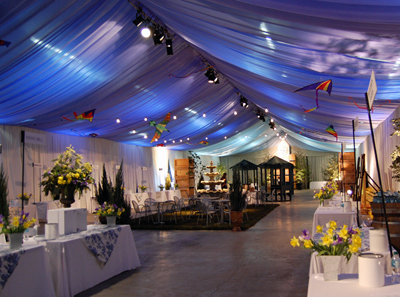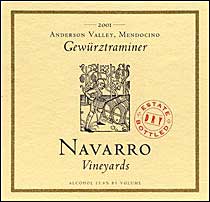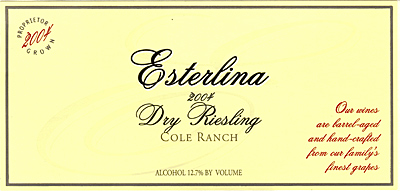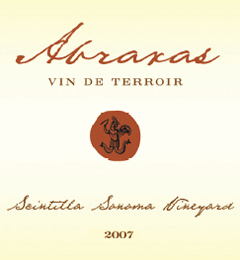

A festive tent welcomed Alsatian wine lovers to the annual Alsace Varietals Festival in Anderson Valley.
Alsace Wines Fested in Anderson Valley
by
Dan Berger
March 11, 2009
 aining a reputation for making great wine is best done vino post facto, which means that the best wines precede the recognition of a quality image. But if word on the wines’ greatness fails to gain broad currency, the region may not gain its rightful place as a region to be watched. And thus has Anderson Valley suffered for the last two or three decades.
aining a reputation for making great wine is best done vino post facto, which means that the best wines precede the recognition of a quality image. But if word on the wines’ greatness fails to gain broad currency, the region may not gain its rightful place as a region to be watched. And thus has Anderson Valley suffered for the last two or three decades.
 But it wasn’t the fault of the wines. They were always excellent if not exceptional, and known in Northern California to be so, especially with certain grape varieties. The strikes against Anderson Valley were partly the making of locals who, oddly enough, desired a degree of anonymity. Any connection to the glitz of Napa is accidental and soon disparaged by the locals.
But it wasn’t the fault of the wines. They were always excellent if not exceptional, and known in Northern California to be so, especially with certain grape varieties. The strikes against Anderson Valley were partly the making of locals who, oddly enough, desired a degree of anonymity. Any connection to the glitz of Napa is accidental and soon disparaged by the locals.
Moreover, most of the wines in Anderson Valley were made to be balanced, more delicate than the brute-force wines that get accolades from the number scorers. But the lack of recognition came too from the locals’ desire to remain a backwater. For one thing, getting to this isolated part of the wine world isn’t easy on two-lane, ever-winding Highway 128 that doesn’t even begin until you’re 90 minutes north of the Golden Gate Bridge. The slow, meandering drive up 128 doesn’t suit day-trippers. And staying overnight isn’t easy since lodging here is scant, and geared toward a slow, casual pace.
Alsace in America
So when Navarro Vineyards wine maker Jim Klein pushed, in 2004, to establish the International Alsace Varietals Festival here, the idea was met with some quiet skepticism. But Klein had his way, and this past Feb. 20 and 21, the fifth annual affair was conducted at the county fairgrounds. So far, word has filtered all the way to Yorkville.
conducted at the county fairgrounds. So far, word has filtered all the way to Yorkville.
Paying homage to Alsace is, in itself, a sort of odd concept. That French region isn’t as widely known as many others, and thus if you asked 100 Americans which wine grape varietals were part of the Alsace district, approximately 100 percent would say they don’t know.
Still, the idea is absolutely sound, and many of the attendees might have been willing to agree with the comment overheard at one of the pouring tables, that “Alsace doesn’t make anything this good.” Taste being subjective, the remark is debatable, but it was clear that those who make wines from the Alsatian varietals (mainly Riesling, Gewurztraminer, Pinot Gris, and Pinot Blanc) loved having an entire barn full of people who did not ask for Cabernet Sauvignon, Merlot, or Zinfandel. And who spoke quietly and respectfully.
Also obvious was the astounding contrast between what took place at the February walk-around tasting and the one roughly a month earlier in San
 Francisco, where the Zinfandel Advocates and Producers (ZAP) staged another of their massive tastings that one Alsace event attendee called “a zoo,” and an “alcohol cruise-around.”
Francisco, where the Zinfandel Advocates and Producers (ZAP) staged another of their massive tastings that one Alsace event attendee called “a zoo,” and an “alcohol cruise-around.”
The dominant features of the Alsace festival here all relate to quietude:
*** The wines were almost all modest in “extraction,” and restrained in showy elements, but all were balanced with excellent acidity, and more aimed at the dinner table than the 100-point score chart.
*** The attendees were reserved, polite, and mostly eager to find wines of varietal character and delicacy. *** The foods served along with the wines were reflections of their compatibility with certain flavors. There were mature soft-ripened cheeses, various kinds of sushi, and an Alsace-oriented “pizza” with sausages, caramelized onions, and a flan-ish base on a classic puff pastry crust.
What also was fascinating was that three Michigan producers who make Riesling and Gewurztraminer were among those who had pouring tables, and most I spoke with had high praise for the wines. Some of which were from neighboring Michigan producers.
The vast majority of wines were from Anderson Valley, which ultimately reaps the greatest reward for this event. Klein of Navarro admitted that after the first two years of the event, “when the attendance was pretty small, we thought about moving it to San Francisco. But we stayed with it, and we love what it has become.”
And that is an homage to classic Riesling and Gewurztraminer, first, and then to blends of the various wines. There were also Pinot Blancs and Pinot Gris. Moreover, many of the local producers displayed, at a Saturday evening gala dinner, some Pinot Noirs (they had been banned from the afternoon tasting). Said one wine maker at the walk-around event, “I don’t know why we can’t have a Pinot here. They make it in Alsace, don’t they?”
Nary a Red Wine: You “Red” That Right
Sure, but most of the “red” wine in Alsace is barely pink in color, and certainly nothing like the deeply intense blueberry-flavored reds we saw at the dinner.
nothing like the deeply intense blueberry-flavored reds we saw at the dinner.
Riesling seemed to be the focus of both a morning technical seminar at the fairgrounds, as well as at the tasting and dinner. And the focus was on dry wines. Both Jim Klein and Harry Peterson-Nedry of Chahalem Winery in Oregon spoke at the tech seminar of the necessity of charging appropriately for the dryer versions of Riesling since, when they are made right, they must come from small tonnages.
“You can’t make a great dry Riesling from high-tonnage fruit,” said Peterson-Nedry, who also lauded the newly founded International Riesling Foundation for establishing a taste scale that defines four levels of sweetness, and is available without charge to all Riesling producers.
The dry Rieslings from Navarro, Handley, Stony Hill, Esterlina, Left Foot Charley (Michigan) and Banyan contrasted nicely with off-dry wines from Chateau Grand Traverse (Michigan), McFadden, Philo Ridge, and Shooting Star.
 One of the more dramatic wines served at the event was the 1007 Abraxas blend from Robert Sinskey Vineyards, which takes all four of the top Alsace varieties and blends them into a fabulous white wine. It was brought to the event by wine maker Jeff Virnig in magnums, and if you’ve never seen a hock bottle in magnum format, it’s a sight to behold.
One of the more dramatic wines served at the event was the 1007 Abraxas blend from Robert Sinskey Vineyards, which takes all four of the top Alsace varieties and blends them into a fabulous white wine. It was brought to the event by wine maker Jeff Virnig in magnums, and if you’ve never seen a hock bottle in magnum format, it’s a sight to behold.
Despite an overc










 READER FEEDBACK: To post your comments on this story,
READER FEEDBACK: To post your comments on this story,




